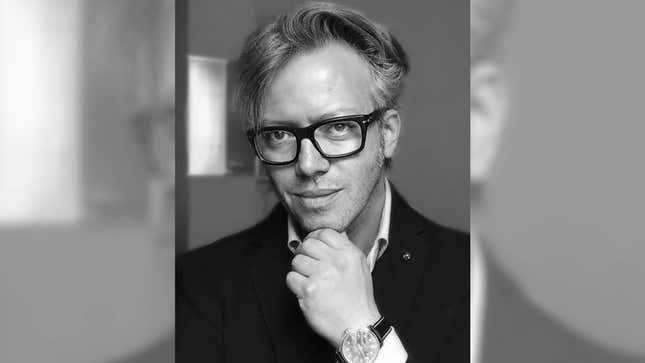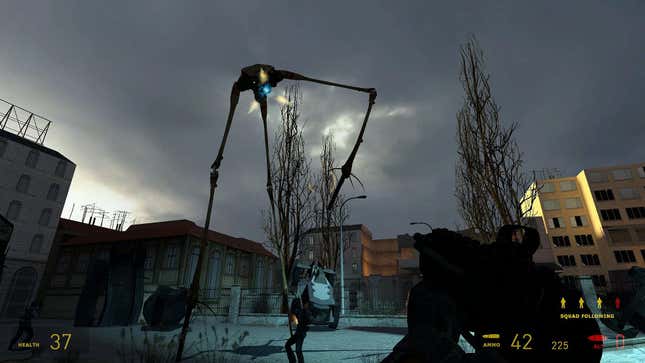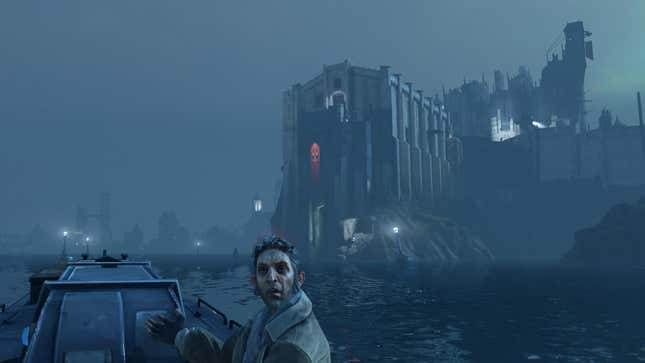
It was announced last week that video game artist Viktor Antonov had died at the unreasonably young age of 52. With stints working at big-name studios like Valve and Arkane, Antonov’s work was a key part of some of the most loved games of all time. It was his unmistakable style that defined Half-Life 2's City 17 and Dishonored’s Dunwall, two of the most distinctive and unforgettable locations in game history. We spoke to people who knew and loved him to learn more about Antonov and his work.
Beginning on memorable games like 1997's Redneck Rampage and 1999's infamous Kingpin: Life of Crime, Viktor Antonov had quickly formed a partnership with fellow game artist Aaron Barber. Barber was hired by Valve, and Viktor soon followed. Marc Laidlaw, the legendary writer behind the Half-Life franchise, told me that once both had been hired and Half-Life 2 development had begun, the two “started in right away.”
Laidlaw had a vision for City 17, but found it hard to properly articulate. Thankfully, Antonov was there. “Viktor was very thorough in trying to understand what we were after, and once he saw the situation, he set about correcting it,” says Laidlaw. “The game was in need of correctives, and strong visual unity, and Viktor provided that, going between the daily practical ‘Yes but how do I actually build it?’ needs of level designers and my vague, atmospheric, ‘It should sorta feel like’ suggestions.”

“I was really smitten with [the stop-motion animation duo] the Brothers Quay,” Laidlaw told Kotaku, “so in my mind we were chasing a shadowy surreal kind of European style, but meanwhile I grew up in Southern California and have never been to Europe, so it could only ever be stylized and abstract, and hard to communicate in terms of spaces designed for combat.” But Viktor, born in Bulgaria, then living in France, Switzerland, Los Angeles and eventually Seattle, had a novel perspective, and more than simply for geography. Laidlaw continued, “Viktor bridged those worlds—between literary abstraction and concrete level design, between general themes and specific architecture.”
We would talk and then he would go off and talk to the artists and designers and slowly a world we could all agree on emerged, full of promise, full of specificity, realistic in some senses but also unique to our game.
Laura Dubuk was a young art student, and working at Valve was her first professional job. Viktor Antonov would be her mentor at the studio, leaving an indelible mark on her career. “For me personally,” Dubuk told me, “he got across how much work and skill it would take to succeed in the video game industry, and how to do it properly. Thankfully he gave me clear direction and led me to learn the fundamentals so I could begin my journey.”
Dubuk continued, “Viktor was a truly unique, unforgettable person. He cared deeply about his friends, and wanted to make sure they were all cared for properly, and going about their lives well and with intention. He was an incredibly observant person which gave him an amazing sense of humor, and was an extremely engaging conversationalist. He was intensely curious and went to the absolute depth of every topic that captured his attention. It goes without saying this curiosity and passion was infectious.”
After many years with Valve, Viktor Antonov moved to Arkane Studios, the developer behind Dishonored and Prey, and it was the former where Antonov had the most distinct influence. Marc Laidlaw noted the impact of his move. “I think you can see that when Viktor went off and designed worlds with Arkane, the similarities between Half-Life 2 and Dishonored show that there was a distinctive Viktor Antonov style that kind of transcended both games and belonged to his original sensibility.”
Raphaël Colantonio, the founder and former president of Arkane Studios, shared the sentiment. “He and Arkane bonded over the shared passion for creating worlds,” Colantonio told me, “free from corporate and commercial influences: we were both idealists, we wanted to do pure art. That sincerity and uncompromised mindset was deeply ingrained in Arkane in general.”
“Viktor was one of those people that you instantly know are one in a billion,” Colantonio said. “I could talk about him for hours. We were extremely lucky to cross paths with him on his way out from Valve.”

Colantonio recalls how Antonov played such a crucial role in designing the look and feel of the game’s central city, Dunwall. “Viktor leveled up Arkane’s art department. He worked closely with [art director] Sébastien Mitton to restructure and change our processes and together they built a world-class team of artists that could rival any top team in the world.”
Harvey Smith, who headed up Arkane Austin, added his memories of Viktor. “An absolute titan like Viktor Antonov working with the already-stacked Arkane art team, led by the incredibly talented Sebastian Mitton and Jean-Luc Monnet, was one of those thunderbolt moments that keeps reverberating forever, across the lives of all the people who worked on or played the Dishonored games. I will always be moved and humbled by what that visual design group created.”
That sense of impact was also brought up by Marc Laidlaw, who sees Antonov’s influence in similarly game-changing ways. “Viktor at that point in time not only benefited the games he worked on, but the industry as a whole,” said Laidlaw, “helping it step away from the wearisome influences of Star Wars and Blade Runner and Alien. I think we agreed that the visual vocabulary of the game industry needed to be drastically expanded, especially when it came to science fiction and fantasy. So if future games end up looking a bit like City 17 or Dunwall instead of Giger or Syd Mead, we will have Viktor to thank.”
Beyond Viktor Antonov’s influence on games and game design, he was also a man people simply loved. Everyone I spoke to was effusive with praise for his decency, passion and warmth.
“Viktor was a force of nature,” said Harvey Smith. “Simultaneously the storm and the rock you cling to. He educated those around him about art, design, and beauty with every breath, even when talking about brutal systems of oppression, like the security systems in Dishonored; perpetually relevant subject matter, it seems. His insights, his powerful presence, and his devastating dry wit will be missed.”
“Viktor was extremely intelligent, articulate, always surprising with shocking yet accurate remarks about world building,” Raphaël Colantonio recalled. “People respected him and were often intimidated because of his serious demeanor (though he was secretly extremely funny). We became good friends, we traveled together a lot. No-one could tie up or control Viktor, but when I left Arkane to start Wolfeye Studios, he consulted for our projects, like in the good old times. I miss him, I miss his funny wit.”
Lovely guy,” said former Valve developer Chet Faliszek, “and being super Frenchy, he was a fun breath of fresh air at Valve.”
“Losing Viktor is a big loss because I know he still had a lot to offer,” Dubuk said, “but again he contributed so much in his life to games and film during his years, and I know we are all grateful for him.”
Marc Laidlaw recalled their shared love of literature, how “a recurrent conversation of ours concerned Nikolai Gogol.” He explained, “Viktor urged me repeatedly to read The Nose and The Overcoat, two of his favorite stories. I can no longer remember his point—probably he was just trying to expand my own vocabulary for literary surrealism. After retirement, I finally got a complete Gogol collection and read through it, with special attention to Viktor’s favorites.”
“One last memory,” added Marc Laidlaw. “My youngest daughter was obsessed with Paris after watching the Mary-Kate and Ashley Olsen movie, Passport to Paris. On one of his trips to France, Viktor returned with a souvenir model of the Eiffel Tower just for her.”
.